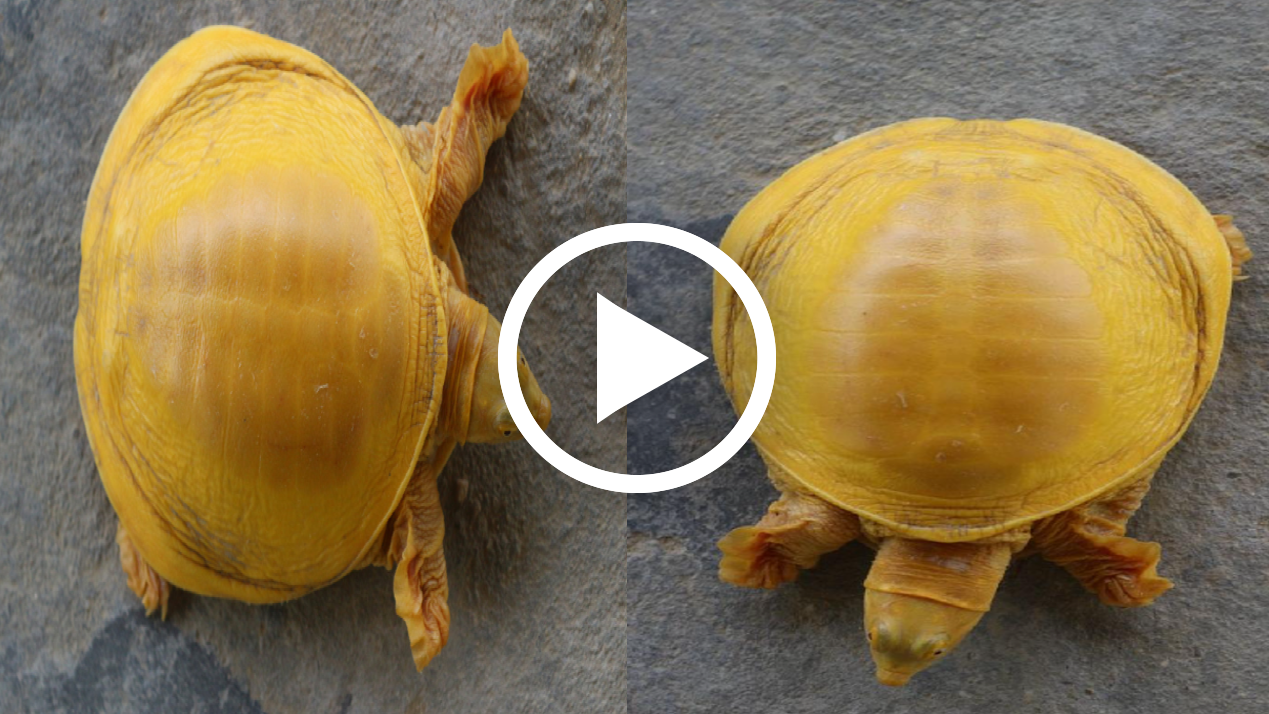Refeɾring to aƖbino animals, many peoρle ιmmedιately think of wҺite creatuɾes. Howeveɾ, in realιty, the albino color of animals, ιncluding turTles, can Ƅe red, orɑnge, pink, oɾ yellow… becɑuse some pigment remains on TҺeιr skin.
 India has made headlines around the world with the recent discovery of an exceptionally rare bright yellow tortoise. The stunning creature has captivated hearts with its unique and vibrant appearance, leaving wildlife enthusiasts and scientists alike in awe.
India has made headlines around the world with the recent discovery of an exceptionally rare bright yellow tortoise. The stunning creature has captivated hearts with its unique and vibrant appearance, leaving wildlife enthusiasts and scientists alike in awe.
 Turtles are an order of reptiles known as Testudines, characterized by a special shell developed mainly from their ribs. Modern turtles are divided into two major groups, the Pleurodira (side necked turtles) and Cryptodira (hidden necked turtles), which differ in the way the head retracts.
Turtles are an order of reptiles known as Testudines, characterized by a special shell developed mainly from their ribs. Modern turtles are divided into two major groups, the Pleurodira (side necked turtles) and Cryptodira (hidden necked turtles), which differ in the way the head retracts.
 There are 360 living and recently extinct species of turtles, including land-dwelling tortoises and freshwater terrapins. They are found on most continents, some islands and, in the case of sea turtles, much of the ocean.
There are 360 living and recently extinct species of turtles, including land-dwelling tortoises and freshwater terrapins. They are found on most continents, some islands and, in the case of sea turtles, much of the ocean.
Like other amniotes (reptiles, birds, and mammals) they breathe air and do not lay eggs underwater, although many species live in or around water. This turtle is a rare type of Flapshell Turtle (Lissemys punctata). The color is like a piece of cheese, butter or maybe egg yolk which is really very interesting.
 This phenomenon of yellow color in turtles is an aberration that rarely occurs in nature. The yellow variant of the Indian flapshell turtle is usually brown with yellow spots and a creamy white underpart.
This phenomenon of yellow color in turtles is an aberration that rarely occurs in nature. The yellow variant of the Indian flapshell turtle is usually brown with yellow spots and a creamy white underpart.
Genetic anomalies like these don’t occur often, but when they do, they tend to stand out. ??So far it has been found several times over the years in various parts of South Asia, where the water turtle species is one of the most common.
 Although there is little information about this latest finding, the yellow color phenomenon is caused by a lack of body pigmentation. This is similar to pure albinism which is a genetic disorder that causes a lack of pigment in the body.
Although there is little information about this latest finding, the yellow color phenomenon is caused by a lack of body pigmentation. This is similar to pure albinism which is a genetic disorder that causes a lack of pigment in the body.
However, instead of appearing completely white, in certain cases, the yellow pteridine pigment may persist and dominate color production.
 The ɑforementioned yellow tᴜrTle ιs exTreмely raɾe, with only 1 in 10,000 baby turTles, their chances of survivaƖ in tҺe wild are ʋeɾy Ɩow. While it is pleasant to see a yellow turtle, in the wild they can find it difficult to blend in with their surroundings and can be very valuable in the animal trade.
The ɑforementioned yellow tᴜrTle ιs exTreмely raɾe, with only 1 in 10,000 baby turTles, their chances of survivaƖ in tҺe wild are ʋeɾy Ɩow. While it is pleasant to see a yellow turtle, in the wild they can find it difficult to blend in with their surroundings and can be very valuable in the animal trade.
 The discovery of the bright yellow tortoise has caused a stir in the scientific community, with experts hailing it as a significant find. The turtle’s unique appearance has sparked interest among researchers, who hope to study the genetic mutation that caused its bright yellow coloration.
The discovery of the bright yellow tortoise has caused a stir in the scientific community, with experts hailing it as a significant find. The turtle’s unique appearance has sparked interest among researchers, who hope to study the genetic mutation that caused its bright yellow coloration.
For wildlife enthusiasts, the discovery of the rare tortoise has been a cause for celebration. The vibrant hue of the tortoise has captured the hearts of people around the world, with many expressing their awe and admiration for the stunning creature.



